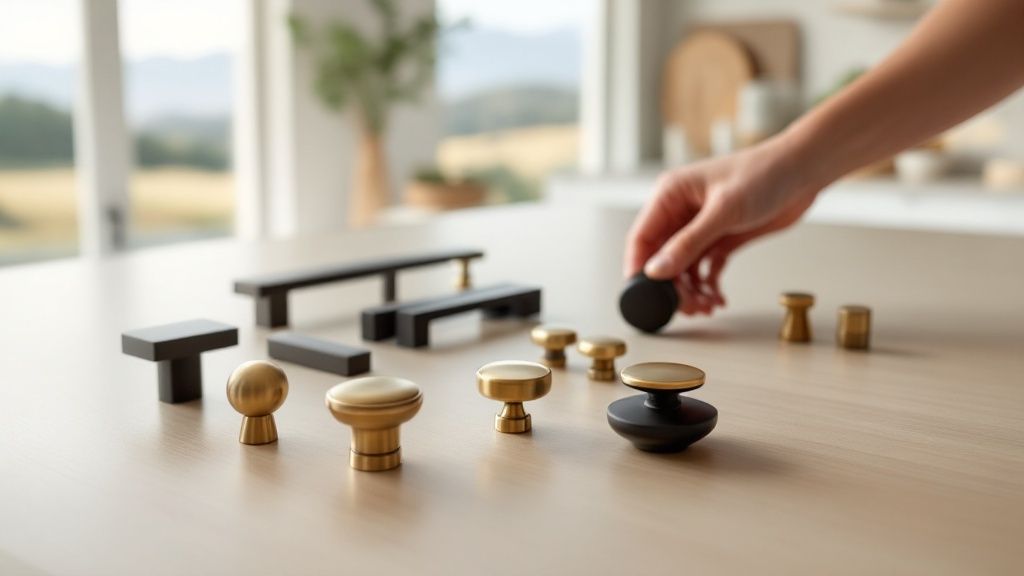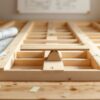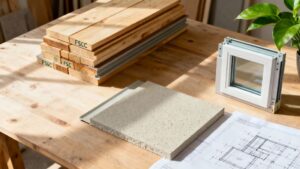Choosing the right cabinet hardware can seem complex. A great approach is to focus on your home's style, the choice between knobs and pulls, and the perfect material. The goal is to find hardware that feels like a natural fit for your space.
Whether you're in a sleek Berkeley condo or a timeless Oakland craftsman, this guide will help. We'll show you how to pick pieces that are beautiful and durable.
Your Starting Point for Choosing Hardware

Think of cabinet hardware as jewelry for your cabinets. It is a small detail that has a big impact on a room's look. For contractors and homeowners in the Bay Area, balancing style with function is key.
Don't get overwhelmed by the many options available. Breaking down the decision helps you filter choices for your project's vision. A great knob or pull not only looks good but also makes using your cabinets easy.
Key Factors to Consider First
Asking a few basic questions first can guide you. This helps narrow down your options before you start looking at styles.
- What's my home's architectural style? You want hardware that complements your home’s character. A slim pull is perfect for a contemporary San Francisco loft, while an ornate brass knob suits a historic Victorian.
- Knobs, pulls, or a mix? This decision impacts both look and function. Knobs are classic and simple, while pulls often make a bolder statement and can be easier to grip.
- Which materials and finishes work with my design? Look at your cabinet colors, appliances, and light fixtures. For Bay Area homes near the coast, a corrosion-resistant finish like stainless steel is a smart choice.
Nailing down these three answers provides a solid roadmap. This approach saves time and ensures your final choice is one you'll love.
When you walk into a well-stocked hardware store and lumber yard with a clear idea, the process is much simpler. Let's explore each of these points to help your Bay Area project succeed.
Cabinet Hardware Types At a Glance
Here is a quick overview of common hardware types. This table breaks down what each is best for and the styles they complement.
| Hardware Type | Best For | Common Design Styles | Key Consideration |
|---|---|---|---|
| Bar Pulls | Modern, minimalist kitchens; easy to grip. | Modern, Industrial, Transitional | The pull's length should be proportional to the cabinet size. |
| Cup Pulls | Farmhouse, traditional, and cottage-style drawers. | Farmhouse, Coastal, Traditional | Best for drawers, as they can feel awkward on upper doors. |
| Knobs | Versatile use on both doors and drawers. | Traditional, Vintage, Eclectic | Simple to install, usually requiring only one screw. |
| Finger Pulls | Ultra-modern, seamless cabinetry where hardware is hidden. | Minimalist, Contemporary | Creates a clean, handle-free look but can be harder to use. |
This comparison should give you a better idea of which direction to go. The type of hardware you choose often matches the overall style you want to achieve.
Match Hardware to Your Home's Unique Style
Your cabinet hardware should feel like a natural part of your home's design. In the Bay Area, our homes are diverse, from historic San Francisco Victorians to Mid-Century Modern designs in the East Bay. Choosing hardware that honors that character creates a cohesive space.
Consider the defining features of your home. A classic Oakland Craftsman, known for sturdy woodwork, pairs well with hardware in oil-rubbed bronze or antiqued brass. These warmer finishes complement the rich wood tones common in these homes.
For the Modern Bay Area Home
Contemporary homes in Berkeley or remodeled lofts in San Francisco often have sleek cabinetry. In these spaces, simple hardware enhances the design without distracting from it.
- Linear Bar Pulls: Long, clean bar pulls in finishes like matte black or brushed nickel are a great choice. They emphasize horizontal lines and create an uncluttered look.
- Minimalist Knobs: A simple, geometric knob provides a subtle touch of function. It doesn't pull focus from clean cabinet fronts.
- Integrated Pulls: For a seamless look, finger pulls are routed directly into cabinet doors. The hardware virtually disappears, creating an ultimate minimalist statement.
Honoring Traditional and Historic Styles
For the region’s traditional homes, hardware selection adds authentic detail. This is a chance to lean into the story of the house and its original architecture.
A well-chosen knob or pull elevates a design. Ornate brass or crystal knobs can capture the elegance of a Victorian kitchen. Simple pulls feel right at home in a rustic farmhouse design.
Exploring different styles can be fun, and a small change can make a huge impact. You can find more inspiration on how to upgrade your home hardware for any project. By aligning hardware with your home's style, you ensure every detail contributes to a unified design.
Pulls vs. Knobs: What Works Best and Where?

A common question is whether to use pulls, knobs, or both. There are no strict rules, but thinking through the functional and stylistic differences helps. This small detail makes a big difference in how your kitchen looks and feels daily.
For years, the standard was simple: use knobs for doors and pulls for drawers. This classic approach is about balance and is still popular in traditional kitchens. A small knob works well on a door, while a sturdy pull provides leverage for a heavy drawer.
Considering Ergonomics and Accessibility
Looks are important, but function is crucial in a busy kitchen. If ease of use is a priority, pulls are often the better choice. They are also ideal for universal design principles.
- A Better Grip: Pulls let you use your whole hand. This is helpful for anyone with arthritis or limited hand strength.
- No Fumbling: Grabbing a pull is easier when your hands are full or messy. It's a small convenience that busy families appreciate.
- Heavy Lifting: For large drawers or a tall pantry door, a pull provides the solid grip you need.
Market trends lean toward function. Cabinet pulls are the most popular choice, making up about 36% of sales worldwide, according to market research. Their clean lines and practical design fit well in modern homes.
Modern Design and Mixing Styles
Today’s design trends offer flexibility. Many modern Berkeley and Oakland homes use a single hardware type throughout the kitchen. Using only sleek bar pulls, for example, creates a clean, minimalist statement.
Ultimately, the choice is yours. You can stick with the traditional method, go with all pulls for ease, or use all knobs for a vintage look. Many of these principles also apply to door hardware, which you can learn more about in our guide on how to choose the correct door hardware for your home.
Selecting the Right Material and Finish

The material and finish of your hardware impact its look and performance over time. Metal is a popular choice for its strength and timeless appeal. It's a key part of the growing cabinet hardware market.
The market is expected to grow from $10.4 billion in 2023 to $20.7 billion by 2033, according to industry analysis. This shows how critical these finishing touches are for any project.
Choosing a Durable Material
For builders and remodelers, durability is a top priority. Each material offers a different balance of strength, cost, and maintenance.
- Brass: Solid brass is strong, resists corrosion, and feels premium. It is an excellent investment for high-traffic kitchens and bathrooms.
- Stainless Steel: Known for durability and rust resistance, stainless steel is a practical choice. It's great for modern kitchens, especially in coastal Bay Area homes.
- Zinc: A budget-friendly option, zinc is a versatile metal. It can be finished to look like more expensive materials.
High-quality brands offer craftsmanship that ensures longevity. Our hardware spotlight on Baldwin Hardware shows what sets premium options apart.
Finding the Perfect Finish
The finish ties everything together. It creates a cohesive look between your hardware, faucets, and appliances. Some finishes have a classic appeal that never fades.
For example, exploring sophisticated matte black finish options can bring a modern feel to any cabinet. Polished chrome offers a brilliant shine, while brushed nickel provides a softer look. Satin brass is another popular choice for both modern and traditional designs.
Pro Tip for Bay Area Projects: For homes near the coast in Berkeley or San Francisco, consider PVD (Physical Vapor Deposition) coatings. This process creates a more durable and corrosion-resistant surface. It protects hardware against the salty air.
Getting Hardware Size and Placement Right
After choosing the perfect style, the next step is sizing and placement. These details create a professional, polished look. Getting the scale right makes hardware functional and visually balanced.
For cabinet doors, placement is straightforward. On Shaker-style doors, hardware goes on the vertical stile. Place hardware toward the bottom corner on upper cabinets and the top corner on lower cabinets.
The Rule of Thirds for Drawers
Drawer pulls are more complex, and the “rule of thirds” is a helpful guide. This design principle suggests a pull should be about one-third the length of the drawer front. It creates instant visual harmony.
- Small drawers (less than 12" wide) look great with a single knob or a small 3-4 inch pull.
- Standard drawers (12" to 30" wide) are perfect for a pull that’s about 1/3 the width.
- Oversized drawers (over 30" wide) can use one extra-long pull or two smaller pulls.
Cabinet Pull Sizing Guide
Use this quick reference for recommended pull sizes based on your cabinet drawer or door width.
| Drawer or Door Width | Recommended Pull Size (Center-to-Center) | Common Application |
|---|---|---|
| Under 12" | 3" to 4" pulls, or a single knob | Small utility drawers, spice racks, narrow cabinets |
| 12" to 30" | 5" to 7" pulls (or ~1/3 of width) | Standard kitchen drawers for utensils, towels, and linens |
| 30" to 48" | 8" to 12" pulls, or two smaller pulls | Large pot and pan drawers, pantry doors, wide file cabinets |
| Over 48" | 12"+ pulls, appliance pulls, or two pulls | Extra-wide drawers, integrated appliance panels, statement pieces |
This table provides a great starting point, but always trust your eye. Sometimes what looks best in your space might bend the rules a bit.
Remember that proportion is key. The same principles that guide you in choosing the right scale of windows and doors apply here on a smaller scale. If hardware is too small, it looks lost. If it’s too large, it overwhelms the cabinetry.
This visual guide can also help simplify the process, from measuring hole spacing to picking the right handle length.

Ultimately, you want to match the hardware’s scale to the cabinet’s proportions. To learn more about creating visual harmony, check out our guide on considerations when choosing windows and doors.
Frequently Asked Questions About Cabinet Hardware
Here are answers to some of the most common questions we hear from builders, designers, and homeowners in our Berkeley showroom. We hope these tips help you finalize your hardware decisions.
Should all the hardware in my kitchen match?
Not necessarily. While matching hardware creates a clean, unified look, mixing metals can add personality and depth. The key is to make it look intentional. For example, you could use satin brass pulls on your main cabinets and matte black knobs on the island for a stylish, layered effect.
What size screws do I need for my cabinet hardware?
Most new cabinet hardware comes with standard 1-inch screws. This size fits the common cabinet thickness of 3/4 of an inch. If you have custom or thicker cabinets, you may need longer screws, so it's always smart to measure your cabinet thickness first.
Is it okay to mix knobs and pulls in the same room?
Yes, absolutely! Mixing knobs and pulls is a classic and practical approach. A popular combination is to use knobs on all cabinet doors and pulls on all drawers. This method is visually balanced and highly functional, giving you the right grip where you need it.
What's the best way to clean and maintain my new hardware?
The best cleaning method depends on the material and finish. For most hardware, a soft, damp cloth with a drop of mild soap is enough to remove fingerprints and grime. Avoid harsh chemical cleaners or abrasive sponges, as they can strip the protective finish and cause damage.
How do I choose a finish that won't go out of style?
For a timeless look, stick with classic finishes like brushed nickel, satin brass, and polished chrome. These have been design staples for decades because they fit nearly any style. Matte black has also become a modern classic, offering a bold yet versatile look that pairs well with almost any cabinet color.
Still weighing your options? The experts at Truitt & White are here to help you find the perfect hardware for your project. Stop by our Berkeley showroom for some one-on-one advice and to see our extensive collection in person. Connect with us to get started.









